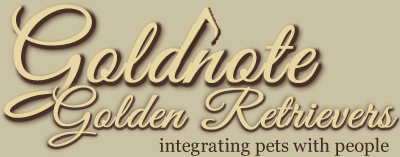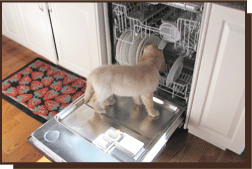We’ve collected some of the questions that we are asked a lot. If your question isn’t in our list, please contact us. We’re happy to answer you.
Clicking on a question below will open/close an answer.
The colour of a Golden Retriever does not make them an English, British, or American Golden Retriever. There are many subtleties to consider when comparing the differences between each style of Golden Retriever. At Goldnote, we will spend time with you explaining and showing you some of the differences between styles and types of Golden Retrievers.
There are many shades of Golden Retrievers that are permissible within the breed standard. In Canadian and European dog shows you will see cream (white) Golden Retrievers through to rich golden shades competing and winning. At Goldnote, we produce cream through to dark mahogany colours in our puppies.
My first choice of a puppy book would be “The Puppy Primer” by Patricia McConnell. Patricia covers so many topics simply and effectively in this book, I consider it to be among the finest. This book and many other excellent titles about dogs and training may be found at www.dogwise.com.
For young people I recommend “101 Dog Tricks“ and “The Best of 101 Dog Tricks” companion video by Kyra Sundance and Chalcy. An excellent buy to help young people become excellent trainers and have a blast doing it! Also found at www.dogwise.com.
A happy and relaxed dog or puppy requires a minimum of 20 minutes of significant physical (fetch, off-lead walking etc.) exercise daily. A Kong chew toy, antler or puzzle ball will keep their mind engaged during your absences – providing further mental stimulation.
Young puppies should not be forced into strenuous physical activities (jogging, biking etc.) until after 18 months of age to protect their joints from serious physical harm. Use caution if you’re unsure. Consult a canine professional if your dog is showing signs of fatigue or lameness during or following exercise.
Although they are a bit more expensive, I prefer a 6’ leather leash for older or adult dogs. I’m not a fan of nylon leashes for older stronger dogs, especially the thin and narrow varieties.
For a brand new puppy you may want to start with a nylon leash though with a small clip that hooks onto the collar as they are less likely to bump into a young dog’s face. A 4’ leash is a minimum, 6’ would be better.
We recommend nylon collars that snap together or buckle. For a new puppy’s first collar we use an adjustable one of about 3/8” wide by 10” to 14” long.
Adult Males require a crate that is 40” long, 26” wide and 32” tall or taller. Adult females require a crate that is 36” long, 24” wide and 32” tall. I recommend that dog owners use an adult male sized crate for both males and females. The extra space allows for more stretching out.
During puppy hood you will need to divide off a portion of the crate until they learn to hold their bowels and bladder better. A large space for a small puppy sometimes encourages them to go “potty” in one end, and sleep in the other end.
Yes, absolutely! We strongly recommend crate training for all dogs and puppies. It is much safer for your home and puppy. It encourages good house training habits, encourages impulse control in stressful situations and reduces stress during veterinary hospital stays or unexpected emergency situations requiring confinement of your puppy or older dog. Crate training is not cruel or mean when used and introduced properly.
They shed a great deal! Regular combing and quality food help, but it does not eliminate shedding. If you’re a very fastidious person or keep a very fastidious home, don’t get a Golden Retriever. The hair does vacuum and sweep up well. But it collects in corners easily too.
Yes! You will require a puppy play pen while your puppy is young so that they can relieve themselves and play safely during your absences. You must also realize that a consistent exercise program before and after work are going to be a necessity. Doggy daycare or dog walking services are also viable alternatives to helping busy families enjoy a dog in their lives.
One of your first considerations when selecting a male or female puppy should be the weight and height of an adult Golden Retriever. Males measure about 23 – 24 inches (58-61 cm) in height at withers (shoulder) and weigh approximately 70 to 85 lbs. Females stand 21-1/2 – 22-1/2 inches (55-57 cm) at the withers and weigh approximately 60 to 70 pounds at maturity.
The difference in temperament of a male and a female is rather subtle. Your best option when considering this question is to visit with us as we are willing to spend time having you meet individual males and females of various ages, allowing you to decide for yourself what personality will meld with your lifestyle best.
Yes. We encourage deposits especially if you are hoping for a particular gender or from a particular father and mother.
Yes, but I prefer to talk personally with you on the telephone or via email too. A questionnaire is one of the most useful tools for you in deciding about a Golden Retriever for your home and it is one of the most effective ways we ensure that our puppies go to great homes.
Goldnote specializes in integrating pets with people naturally. We want each of our puppies to go to caregivers who will love and care for them for many years to come.
Our preference is to meet the entire family who will be living with and caring for a new puppy. This helps us get to know you better. A visit with everyone also generates plenty of questions and useful dialogue between us and your entire family about the challenges of a new puppy. It also builds in the added bonus of socialization for young dogs and puppies here at Dogwood Farm. This benefits the entire Goldnote family of dogs and future family pets.
Yes! We would be happy to arrange a visit with you. Please call or email us to set up a visit with our Goldnote family.







